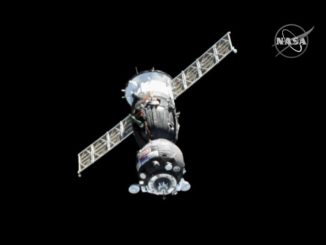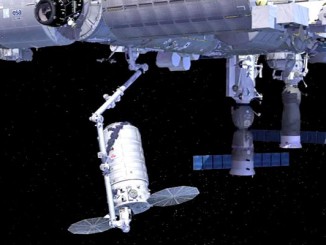CAPE CANAVERAL — Disconnected from the International Space Station berthing port and then cast free by the robotic arm, the commercial Cygnus cargo craft flew away today after successfully restarting U.S. resupply service to the outpost.
The Orbital ATK maneuvering freighter was released from Canadarm2 at 7:26 a.m. EST (1226 GMT) some 250 miles above South America.
Ground controllers set the stage early Friday by remotely operating the arm to detach Cygnus from the Earth-facing side of the station’s Unity module at 5:40 a.m. EST. Expedition 46 crewmates Scott Kelly and Tim Kopra, working in the multi-window Cupola, then took over control for the release, which occurred from a point about 30 feet below the station.
That concluded 72 days spent at the station for the Cygnus, dubbed the SS Deke Slayton II for the late Mercury 7 astronaut.
So grateful for the supplies from the #Cygnus cargo vehicle. All set for release tomorrow. @OrbitalATK pic.twitter.com/74etYiPhnj
— Tim Kopra (@astro_tim) February 18, 2016
The ship was launched Dec. 6 atop a United Launch Alliance Atlas 5 rocket from Cape Canaveral and performed a rendezvous with the station on Dec. 9 for capture and berthing.
Marking the first flight of the Enhanced Cygnus with a larger cargo container, the vessel carried 7,383 pounds of provisions, not counting packing materials, for the station and its resident crews, including clothing, food, replacement parts, new computer and camera gear, spacewalk equipment and science experiments.
It was filled with about 3,000 pounds of garbage and disposables prior to departure to help clean the interior of the space station.
The Orbital ATK vehicle control team in Virginia plan for the Cygnus to execute its deorbiting, a two-burn operation over three orbits, on Saturday for a destructive re-entry into the Pacific.
Sped up view of @OrbitalATK #Cygnus detached from Unity module with @CSA_ASC #Canadarm2. https://t.co/Nq6NJxCN4Y
— Intl. Space Station (@Space_Station) February 19, 2016
The ship was the first from the U.S. to reach the station after launch failures suffered by both commercial providers — Orbital ATK and SpaceX.
Orbital ATK purchased a pair of Atlas 5 rockets from ULA as gap-fillers to resume Cygnus launches while changing the engines that power the first stage of its own Antares booster.
That second Atlas will be used next month, launching another Cygnus on March 22 just after 11 p.m. EDT with a full load of supplies.
The two Atlas/Cygnus missions are expected to deliver over 15,000 pounds of cargo in a 100-day span.
Stacking of the Atlas 5 rocket begins next week at Cape Canaveral. The Cygnus will move to its fueling station on Monday.
Launch was delayed from March 10 so NASA could remove the cargo bags already placed in Cygnus to perform precautionary mold decontamination.
See earlier Cygnus OA-4 coverage.
Our Atlas archive.



